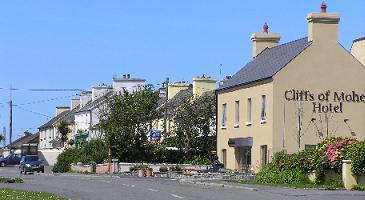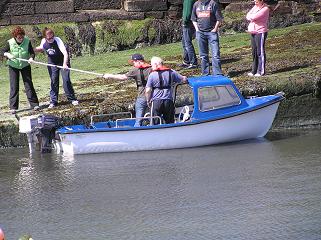Liscannor...

Liscannor is a coastal village on the west coast of County Clare Ireland on the Wild Atlantic Way route. This is a small rural village located at the end of Liscannor Bay, on the R478 road between Lahinch, to the east, and Doolin, to the north. It is noted as the birthplace of engineer and submarine innovator John Philip Holland, there is now a small museum opened to this remarkable innovator. There are a number of pubs and bed and breakfasts in Liscannor as well as a Hotel and self-catering.
Liscannor is a busy tourist village in the summer but in the winter the population dwindles. The Cliffs of Moher are just a short drive from the village, there is a designated coastal walk to the cliffs and onto Doolin (if you like) beginning in Liscannor. On the main road to the Cliffs of Moher just outside the town is an interesting place to stop, a holy well dedicated to Saint Bridget. People visit St. Bridget's well for its curative properties. You will see people walking around it saying decades of a rosary, and this particular well is noted for the wealth of votive religious objects left there like images of the Virgin Mary or Rosary beads that are hung up on the wall, it's a real treat to see.
Liscannor is home to an annual coursing meeting in spring. It is also home to Joseph Mc Hughs bar, made famous by it 's original owner, who still lends his name to the business and the song which tells of this larger than life character. It's close proximity to Lahich makes it a haven for golf enthusiasts year round.

Angling is popular both at the pier, and at liscannor beach located just before the pitch-in-put course on the road to Lahinch. For the kids Moher Hill Open Farm and Leisure Park offers hours of fun.
One of the most enduring features of this landscape is the use of the local flagstone, locally called Liscannor stone, it is used in farm walls, houses, paving, flooring and on roofs. Liscannor was home to a thriving quarrying industry employing 500 men in at least nine quarries in the area. The quarries were so prosperous in the early 1900's that a village was built around the famous Doonagore mines which also put Liscannor port on the map. It was one of the busiest of the small ports along the west coast of Ireland with its shipments of stone to London and Liverpool. The advent of Word War I put an end to all the prosperity and when the boats were unable to travel the mines closed. However, a number of mines were re-opened on a smaller scale in the Liscannor area in the 1960's and are still producing the famous stone. An audio visual room at Liscannor rock shop illustrates quarrying methods through the ages, and houses a collection of quarrying tools by and photographs displaying Liscannor in the 1800's.
The rock shop is a quirky little shop selling all things made of stone. Other shops in the area include a couple of art stores, a woolen shop and a gift shop.